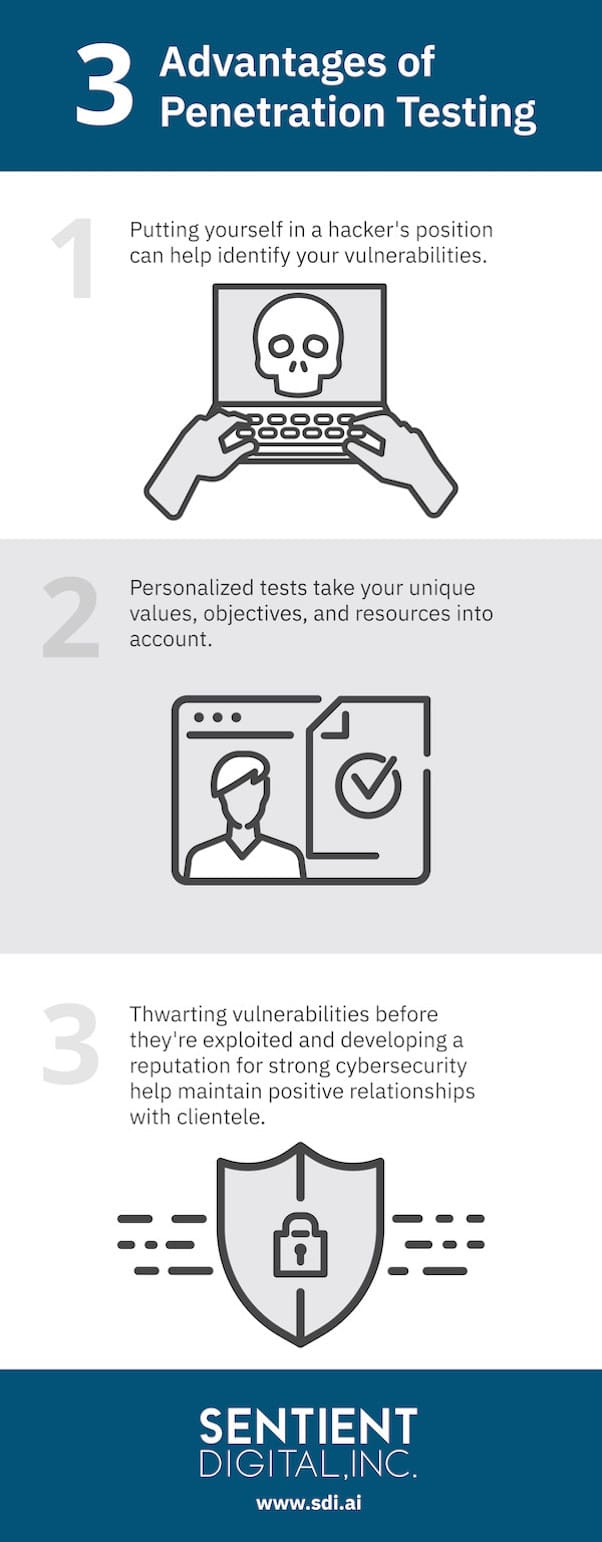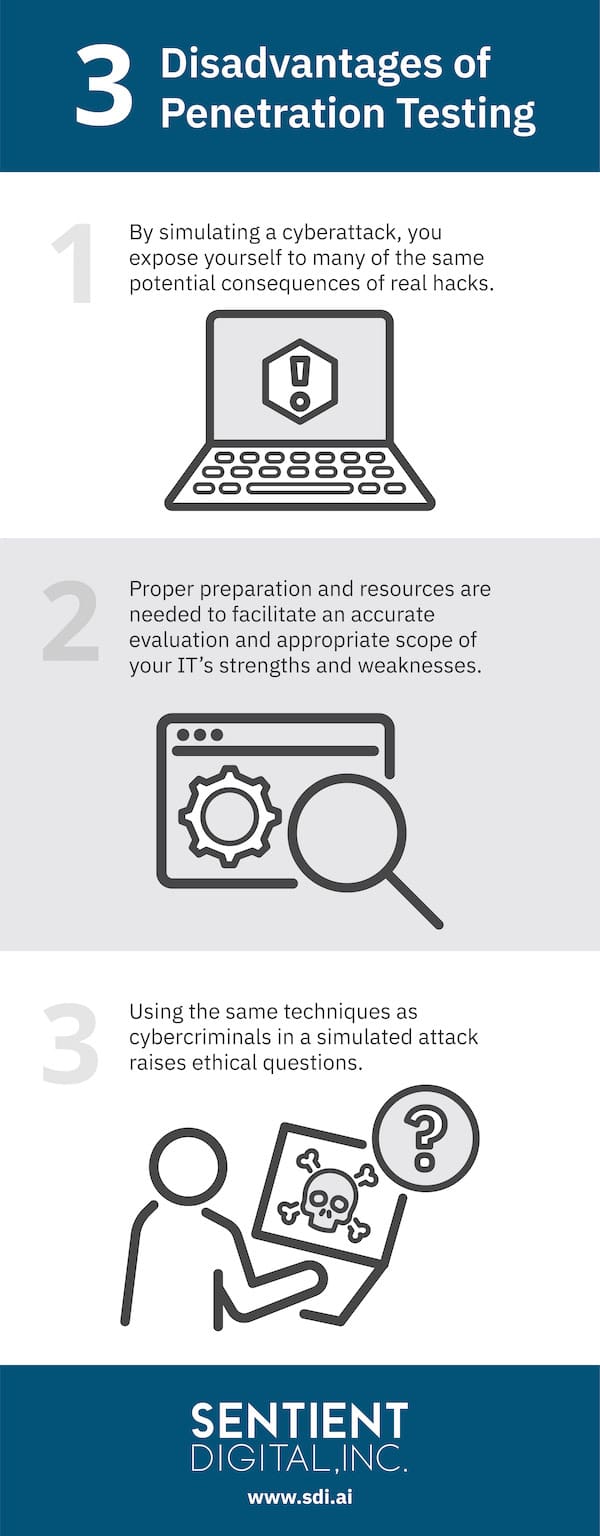Businesses, government agencies, and other organizations today are implementing more and more sophisticated cybersecurity, leveraging everything from cyber crime-fighting artificial intelligence, to paying professionals to try to hack their systems, to protect against the ever-evolving nature of cyberattacks. One such tactic, penetration testing, is on track to become a $4.5 billion industry by 2025. If this technique is so popular, you might wonder whether the advantages of penetration testing make it a worthwhile investment for your organization. You may also wonder about any disadvantages that might give you second thoughts. This article will address both, so that you can make an informed decision.
What is Penetration Testing and How Do You Know If It Is The Right Approach For Your Organization?
Penetration testing describes the process of simulating a cyberattack against a computer system, network, website, or application. The goal of penetration testing is to identify any weaknesses that cybercriminals could exploit before a malicious attack occurs.
While the practice of penetration testing is growing in popularity, it comes with risks. There are a few top advantages and disadvantages of penetration testing to consider, which will be discussed in greater detail below.
WHAT ARE THE ADVANTAGES OF PENETRATION TESTING?
- Identify and resolve system vulnerabilities
- Gain valuable insights into your digital systems
- Establish trust with your clientele
WHAT ARE THE DISADVANTAGES OF PENETRATION TESTING?
- Mistakes can be costly
- Determining the test conditions
- Testing could be unethical
Are the advantages of penetration testing worth the potential negative implications of penetration testing? If you decide you want to proceed, how do you get started? Keep reading to learn about the role of penetration testing, the advantages and disadvantages of penetration testing, different types of penetration tests, and more to help evaluate this cybersecurity tactic.
THE ROLE OF PENETRATION TESTING

Also called “ethical hacking,” “white-hat hacking,” or “pentesting,” penetration testing is a complex and diverse cybersecurity strategy. Note that ethical hacking can sometimes also refer to different actions or a broader range of actions than penetration testing. If the overarching process of cybersecurity is valuation of assets, threat identification, vulnerability identification, risk profiling, and risk treatment, penetration testing takes place at the vulnerability identification and risk profiling steps.
According to security technologist Bruce Schneier, the goal of penetration testing is “protection, detection and response—and you need all three to have good security.” Penetration testing helps you detect weaknesses in your IT, so you can respond with heightened protective measures around your biggest assets and most threatening vulnerabilities.
Penetration testing entails frequent internal security audits by a team of trained employees or IT professionals. The experts who conduct penetration tests are called “pentesters.” Pentesters have the technology and hacking knowledge to create a mock hack on your system, network, or application.
There are both manual and automated methods to identify weak points in any IT infrastructure. These tactics can provide insight into where your vulnerabilities lie and what kinds of cyberattacks your organization may be susceptible to.
The scope of penetration testing can vary depending on the needs of your organization. A small business may only need a simple single web application penetration test, for example, while a larger corporation may require a full-scale penetration test of all its technology systems.
Penetration testing should never be an organization’s sole security measure, but an advantageous component to holistic cybersecurity. For some larger industries, it may be a requirement of their regulatory standards and compliance guidelines. Even for smaller organizations, penetration testing may warrant consideration if you routinely deal with sensitive data or materials, or have other reasons for a higher level of concern about cyber attacks.
While it can be expensive and complicated, pentesting is a valuable service and can fit easily into a company’s security protocol. Many businesses perform penetration testing regularly during scheduled security audits.
Penetration testing is a widely practiced method of cybersecurity. However, as with all security tactics, it is not perfect. Consider some of the most important advantages and disadvantages of penetration testing before implementing it at your organization.
ADVANTAGES OF PENETRATION TESTING

Learn more about the advantages and disadvantages of penetration testing below! Please feel free to share our infographic on social media, or copy and paste the code below to embed it on your website:
<img src="http://bit.ly/3advantagespentesting">
<p>3 Advantages of Penetration Testing: an infographic by the team at
<a href="https://sdi.ai/">Sentient Digital, Inc.</a></p>
The cost of cybercrime is anticipated to reach $10.5 trillion a year by 2025. Already a common security practice among major enterprises, penetration testing will likely continue to gain popularity as the frequency and complexity of cyberattacks continue to grow for organizations of all sizes. Despite the risks, there are a number of valuable advantages of penetration testing.
1. IDENTIFY AND RESOLVE SYSTEM VULNERABILITIES
A new cyberattack occurs every 39 seconds, putting businesses constantly at risk. Hackers can find vulnerabilities in areas you may have never thought to look.
Penetration testers perform the valuable work of finding vulnerabilities in your company’s digital systems and data. One of the major advantages of penetration testing is that pentesters put themselves in a hacker’s position. By demonstrating what a bad actor could do to your business in its current state, you will be able to see where your digital systems may need increased security and where you are already well protected. By staying on the pulse of the cybersecurity world and regularly approaching your IT systems from a cybercriminal’s perspective, pentesters can identify a wide range of vulnerabilities and weaknesses with your IT.
2. GAIN VALUABLE INSIGHTS INTO YOUR DIGITAL SYSTEMS
Reports from penetration testing can provide you with valuable details about your network, its weak points, and how to strengthen it. These tests are in depth and can be analyzed by pentesters and IT professionals alike for a variety of purposes.
Automatically generated reports from online vulnerability tests and assessments tend to be more generic than penetration test reports. By helping to rank your risks and make actionable plans aligned with company values, objectives, and resources, penetration tests can give you specific aspects of your IT to focus on based on personalized insights.
3. ESTABLISH TRUST WITH YOUR CLIENTELE
A cyberattack or data breach negatively affects the confidence and loyalty of your customers, vendors, and partners. Investing in proactive cybersecurity to protect your IT systems and data from attack is one of the most important advantages of penetration testing. You can also develop a reputation for maintaining a standard of excellence regarding cybersecurity to reassure current and prospective customers.
Certifications, such as the Cybersecurity Maturity Model Certification (CMMC) for defense contractors, can help with this. Another helpful practice is sharing as much as you safely can about how your organization adheres to principles of information assurance, how your cybersecurity protects your business’ and clients’ data, and how frequently and thoroughly you conduct systematic security reviews and penetration tests.
Many companies have policies in place that require them to perform regular penetration tests or must do so in order to adhere to industry standards and regulations. An advantage of penetration testing is that it is able to help ensure that a company is up to standard in terms of security obligations, such as those mandated by the PCI, HIPAA, FISMA, and ISO 27001.
Regular penetration testing demonstrates dedication to the security of your digital systems to your clients, as well as to your industry. Additionally, this practice helps your company to avoid the fines and other consequences that may come with non-compliance, or the financial losses that can result from a cyber attack even when penetration testing was not required.
If your organization does have a choice about whether or not to conduct penetration testing, you will want to take into account the disadvantages of the practice when making your decision.
DISADVANTAGES OF PENETRATION TESTING

Learn more about the advantages and disadvantages of penetration testing below! Please feel free to share our infographic on social media, or copy and paste the code below to embed it on your website:
<img src="http://bit.ly/3disadvantagespentesting">
<p>3 Disadvantages of Penetration Testing: an infographic by the team at
<a href="https://sdi.ai/">Sentient Digital, Inc.</a></p>
The process of penetration testing involves hacking your IT systems to expose areas of vulnerability. By its very nature, this method of “ethical hacking” includes several risks.
Disadvantages of penetration testing include potentially causing costly losses of sensitive information, encouraging hackers, or exposing your network to cybercriminals. Before implementing penetration testing, you’ll need to determine if it seems like an ethical and reliable enough tactic for your organization.
1. MISTAKES CAN BE COSTLY
Penetration testing involves hacking some, if not all, of your IT systems. It can expose sensitive security issues concerning company and customer information.
If penetration tests are not conducted properly, they can cause a lot of damage. Servers may crash, crucial data may be corrupted, or other consequences of a criminal hack can occur.
Losing your company’s private data would be disastrous, especially if it fell into the hands of an actual hacker or a rival company.
2. DETERMINING THE TEST CONDITIONS
When examining the pros and cons of penetration testing, be aware that it can be very complex and expensive. You have to determine the test conditions and scope that are worth the risks and resources associated with this tactic.
Is it worth the risk to your company’s security just to analyze one specific area of your network? Given the significant potential disadvantages of penetration testing, it may be better to make the most of each test with a wider scope.
If you wish to conduct a penetration test on your entire network and infrastructure, however, you’ll need to make sure your pentesters are prepared to explore every aspect of your IT. This takes even more effort, detail, and resources.
At the same time, some businesses plan too heavily for a penetration test. Real cyberattacks occur with little to no warning. Make sure your network and systems face the most realistic test conditions possible for the most accurate results.
Opening up your organization to the risks and disadvantages of penetration testing won’t be worth it if you do not receive an accurate evaluation and appropriate scope of your IT’s strengths and weaknesses.
3. TESTING COULD BE UNETHICAL
Is penetration testing ethical? Because it uses many of the same techniques that a criminal uses to search for vulnerabilities in an organization’s systems or applications, the ethics of penetration testing often come under question.
Some argue that penetration testing incentivizes negative behavior and tactics, since the hacking that is performed in these tests does not differ from hacking performed by cybercriminals. This argument may imply that penetration testing essentially reveals the kinds of techniques that bad actors can use to gain access to an organization’s systems.
Every organization will need to decide for itself if it can accept the ethical implications of penetration testing, in order to receive the benefits of penetration testing. It is also important to consider how customers, vendors, and partners may view the ethics of penetration testing. Clearly, organizations must carefully vet the penetration testers they choose, as trust is absolutely critical when inviting these highly skilled professionals to find security vulnerabilities.
Alternatives to Penetration Testing
If these disadvantages have you concerned that penetration testing does not fit your organization at this time (and if it is not required in your organization) many other approaches to risk assessment exist. For example, if the cost of the test is a barrier, you could choose to conduct only certain components of it. These might include a vulnerability scan, phishing simulation, and attack surface analysis. Using some or all of these components you can save the cost of the full penetration testing while still achieving some of the cybersecurity benefits.
If ethics, rather than cost, are your primary objection to penetration testing, consider working with a trusted custom technology solutions provider. Such an organization can create a customized cybersecurity plan that excludes elements that you would consider unacceptable ethical risks.
However, if you want to continue investigating how you can experience the potential advantages of penetration testing in your organization, take a closer look at the different types available to you.
DIFFERENT TYPES OF PENETRATION TESTS

Penetration tests can differ depending on the perspective pentesters adopt and the scope of the test. Determining which type of penetration test works best for your specific IT infrastructure and security concerns can help eliminate certain risks and reduce the disadvantages of penetration testing.
EXTERNAL NETWORK PENETRATION TESTING
External network penetration testing involves pentesters hacking into your systems without any level of previously established access to your network. In other words, pentesters using this testing method access your network’s areas of vulnerability from the systems’ perimeter.
This type of test is typically done off-site to accurately simulate a real-life cyberattack executed by an outsider. A major advantage of penetration testing like this is that it prepares your organization for a threat everyone faces: attacks performed off-site and outside of the network infrastructure.
However, when considering the pros and cons of penetration testing, bear in mind that one of the negative implications of penetration testing externally is that it can expose sensitive information, as well as corrupt data in your company’s software. The way in which this could happen is if a penetration tester were to discover a vulnerability, such as a back door, but not protect it, giving a real attacker easy access to the company’s data. The way to avoid this is to have an experienced penetration testing team following best practices. Having good communication within the team and with the organization as a whole, and ensuring experienced testers are in charge of the test will ensure no mistakes are made. Overall, the advantages of penetration testing likely outweigh these potential consequences, as you cannot protect against threats of which you are unaware. External network penetration testing enables a company to obtain a thorough idea of what areas might be easiest for external threats to access and where a company may need to improve its security measures.
INTERNAL NETWORK PENETRATION TESTING
Internal network pentesting is designed to simulate an internal attack perpetrated by a malicious network user or employee. The pentester performs the hack from two different perspectives: as an authenticated user and as a non-authenticated user.
The goal is the same for an internal test as an external test, but this method assumes that the hacker already has access to your network in some capacity. Even if none of your workers actively seek to harm your organization, many data breaches involve coerced or unknowing involvement from an employee, vendor, or other user with access to your network.
In addition to performing ongoing cyber monitoring and regular cybersecurity training for employees, conducting internal network penetration testing can help your organization prepare for this very real possibility.
An internal network threat is a possibility that may not initially occur to you. While a company’s employees need to be trusted with sensitive information, an internal threat is something for which companies must always prepare. The benefits of penetration testing internally are far greater than the downsides. An internal network penetration test is a very useful test to perform as it can give a company a different perspective on the vulnerabilities and potential areas where a hacker could have easy access to their data. Internal network testing can also aid in building client trust and loyalty in the company. Any client wants to have trust in a company to protect their information from external and internal threats. Internal network testing can provide a company with an extra level of assurance that their sensitive data will not be accessed by anyone unauthorized to do so.

WEB APPLICATION PENETRATION TESTING
More and more companies are beginning to build their entire frameworks online. This makes many businesses susceptible to hackers via their websites or website applications.
As the number of websites and web applications grows, their low security frameworks make them easy targets for hackers to attack larger networks. This type of penetration testing evaluates the development, design, and coding of your website or web application to find any areas that expose sensitive customer information or company data.
With the widespread use of smartphones, businesses have had to develop mobile-friendly websites, as more individuals are opting to use their mobile phones to access company websites. Many websites require individuals to input personal information and mobile phones have become more prone to attacks, thus exposing sensitive data and customer information. While many companies will test for vulnerabilities in their own databases, they may not adequately ensure the security of the data input into their mobile applications. A web application penetration test can correct this oversight and help a company improve their online security for themselves and their clients.
SOCIAL ENGINEERING PENETRATION TESTING
Social engineering is the most controversial method of penetration testing. It involves manipulating your employees and using them to gain access to your network in a simulated cyberattack.
Pentesters may send your employees a phishing email or text to see if they fall for it. Or they may otherwise impersonate a company leader via email, text, phone call, or video call and attempt to extract information from employees. They might comb through workers’ social media profiles to see if any information is available to help them crack an employee password or security question.
They could visit your office and see if they’re able to get into the building. Once inside, pentesters might leave a USB device containing malicious code for workers to find, or see if they are able to gain passwords or other sensitive information by searching workers’ desks and trash cans.
Social engineering penetration testing can be used to reveal your network users’ vulnerabilities and weaknesses. Compared to other test types, one of the main advantages of penetration testing like this is that it gauges your employees’ knowledge and implementation of safe cybersecurity practices. These tests can also easily be adapted to look for security issues with working remotely or in person.
However, this type of penetration testing requires additional preparation and follow up. Employees should understand that the goal is to strengthen your organization’s cybersecurity, not embarrass those who make mistakes or sabotage their career trajectories. Whenever a worker does compromise your organization’s security during one of these tests, they should receive additional cybersecurity training.
TRUST SENTIENT DIGITAL FOR YOUR PENETRATION TESTING AND OTHER CYBERSECURITY NEEDS

Have you decided whether or not you are ready to implement penetration testing into your organization’s cybersecurity practices? Sentient Digital, Inc. can create an expert strategy customized for your unique needs, while helping you responsibly balance the advantages and disadvantages of penetration testing. Even if you determine that the approach is not right for your organization at this time, Sentient Digital’s team of cybersecurity subject matter experts will leverage their knowledge and skills to find the best approach for your organization.
We provide technology solutions you can trust. Our team is highly skilled and professional, and our company has a proven track record and a range of industry certifications. Not only are we equipped to conduct penetration testing, but we also implement the vulnerability remediation required to correct specific issues and strengthen your security. We offer advanced cybersecurity services in multiple different domains, including penetration testing, security and risk management, security engineering, information security, threat modeling, and much more.
Contact us online or call us today at 504-308-1464 to discuss how our robust, personalized approach to penetration testing and other cybersecurity measures can help your organization meet the challenges of today.




